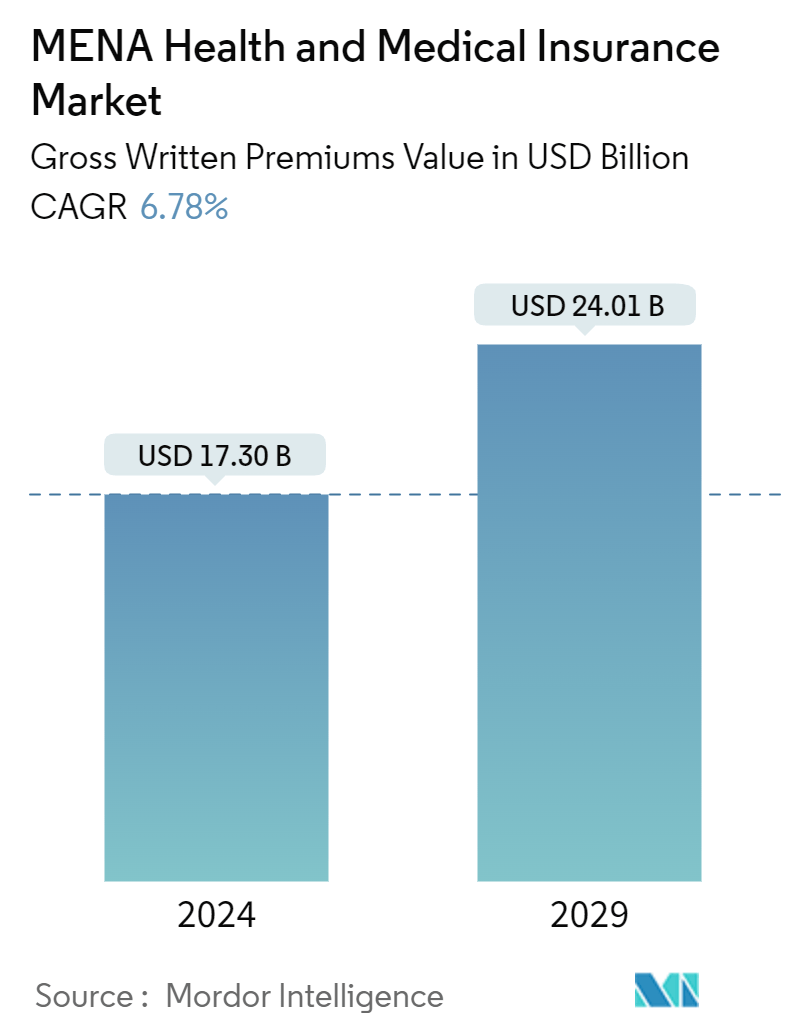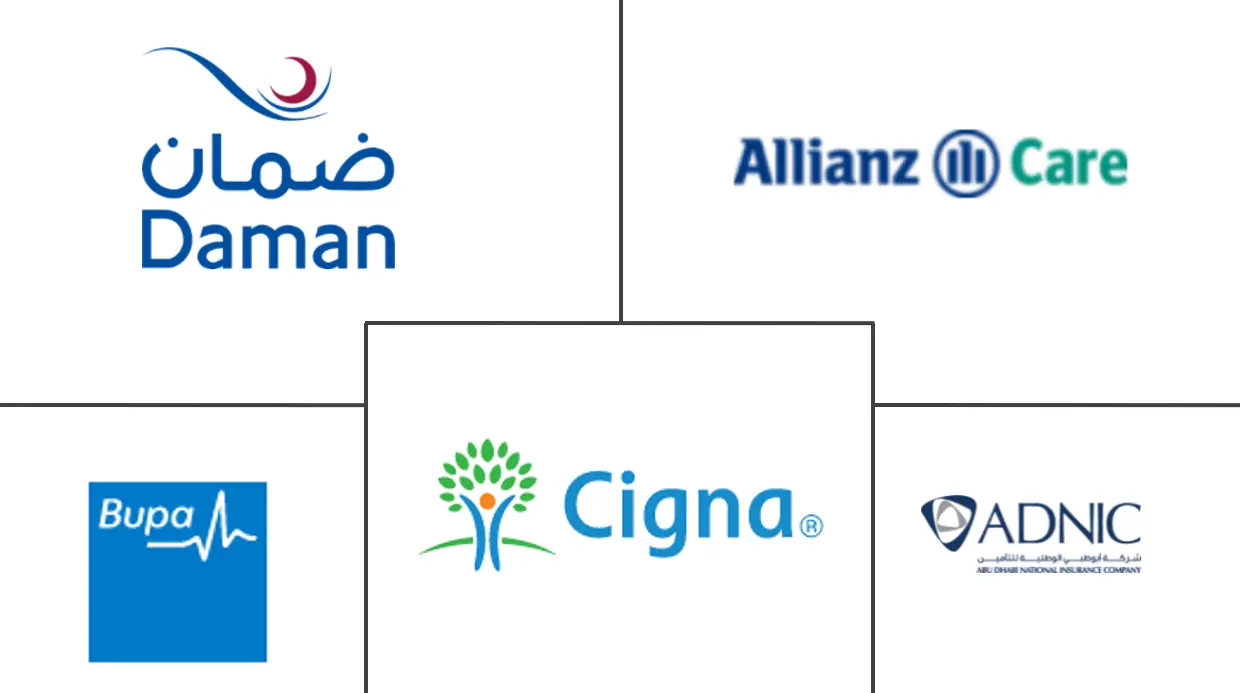Market Size of MENA Health And Medical Insurance Industry

| Study Period | 2020 - 2029 |
| Base Year For Estimation | 2023 |
| Market Size (2024) | USD 17.30 Billion |
| Market Size (2029) | USD 24.01 Billion |
| CAGR (2024 - 2029) | 6.78 % |
| Market Concentration | Low |
Major Players
*Disclaimer: Major Players sorted in no particular order |
MENA Health & Medical Insurance Market Analysis
The MENA Health And Medical Insurance Market size in terms of gross written premiums value is expected to grow from USD 17.30 billion in 2024 to USD 24.01 billion by 2029, at a CAGR of 6.78% during the forecast period (2024-2029).
The MENA health and medical insurance sector is robustly growing. Health insurance is a financial buffer, addressing medical costs from illnesses, injuries, and unexpected events. Individuals rely on their insurance providers for compensation in unfortunate scenarios, such as accidents or medical procedures. This market expansion is fueled by escalating health concerns tied to lifestyle choices, a burgeoning population, demographic transitions, and heightened demands from the healthcare sector. While the sector grappled with a spike in claims during the COVID-19 pandemic, many companies adeptly pivoted, rolling out pandemic-centric insurance policies.
Countries like Saudi Arabia and the UAE exhibit a pronounced penetration of health and medical insurance. The UAE stands out with its mandate for universal health insurance coverage for all residents. In accordance with Abu Dhabi's Law No. 23, employers are obligated to insure their employees and their dependents. In contrast, Egypt's health insurance domain is largely steered by the private sector. As the region emphasizes both access to and quality of healthcare, the Middle East's health insurance market is set to play a pivotal role in safeguarding the financial well-being of individuals and families in the years ahead.
MENA Health & Medical Insurance Industry Segmentation
Health insurance covers a range of medical treatments, including surgical expenses.
The MENA health and medical insurance market is segmented by insurance providers, demographics, distribution channels, coverage, and country. By insurance providers, the market is segmented into public sector insurers, private sector insurers, and standalone health insurance companies. By demographics, the market is segmented into adults, minors, and senior citizens. By distribution channel, the market is segmented into direct sales, agents, online, bancassurance, and other distribution channels. By coverage, the market is segmented into individuals and families or groups. By country, the market is segmented into Saudi Arabia, United Arab Emirates, Egypt, Kuwait, Qatar, and Rest of Middle East and North Africa. The report offers market size and forecasts in value (USD) for all the above segments.
| By Insurance Providers | |
| Public Sector Insurers | |
| Private Sector Insurers | |
| Standalone Health Insurance Companies |
| By Demographics | |
| Adults | |
| Minors | |
| Senior Citizens |
| By Coverage | |
| Individual | |
| Family or Group |
| By Distribution Channel | |
| Direct Sales | |
| Agents | |
| Online | |
| Bancassurance | |
| Other Distribution Channels |
| By Country | |
| Saudi Arabia | |
| United Arab Emirates | |
| Egypt | |
| Kuwait | |
| Qatar | |
| Rest of the Middle East and North Africa |
MENA Health And Medical Insurance Market Size Summary
The MENA health and medical insurance market is poised for substantial growth, driven by factors such as increasing healthcare demand, population expansion, and lifestyle-related health issues. The sector is witnessing a surge in market penetration, particularly in countries like Saudi Arabia and the United Arab Emirates, where health insurance is mandatory. The COVID-19 pandemic has further influenced the market, with an increase in claims prompting some insurers to expand their offerings to include pandemic-related policies. The market's expansion is also supported by regulatory frameworks and initiatives like the Universal Health Insurance system in Egypt, which aims to enhance healthcare services and insurance coverage through various funding sources and government support.
The market landscape is characterized by a high level of competition, with numerous players operating across the region. In the United Arab Emirates, the National Health Insurance Company (Daman) holds a significant position, supported by strategic acquisitions and partnerships to enhance its service offerings. The fragmented nature of the market is evident with over seventy-five licensed companies in Dubai alone, catering to a diverse clientele. Companies like Bupa Global, Cigna, and Allianz are also key players, offering comprehensive insurance solutions to meet the needs of expatriates and local residents. The focus on improving healthcare infrastructure and insurance services, coupled with investments from entities like the World Bank, underscores the region's commitment to achieving universal health coverage and improving the quality of public healthcare.
MENA Health And Medical Insurance Market Size - Table of Contents
-
1. MARKET DYNAMICS AND INSIGHTS
-
1.1 Market Overview
-
1.2 Market Drivers
-
1.2.1 Increasing Healthcare Spending Propels the Market's Expansion
-
1.2.2 Government Initiatives are Propelling the Market's Growth
-
-
1.3 Market Restraints
-
1.3.1 Rising Insurance Premiums may Hinder the Market's Expansion
-
-
1.4 Market Opportunities
-
1.4.1 Introduction of Mandatory Health Insurance Schemes
-
1.4.2 Digital Platforms Revolutionize Insurance Services Adoption
-
-
1.5 Value Chain Analysis
-
1.6 Industry Attractiveness: Porter's Five Forces Analysis
-
1.6.1 Threat of New Entrants
-
1.6.2 Bargaining Power of Buyers
-
1.6.3 Bargaining Power of Suppliers
-
1.6.4 Threat of Substitutes
-
1.6.5 Intensity of Competitive Rivalry
-
-
1.7 Insights into Technological Advancements in the Industry
-
1.8 Impact of the COVID-19 Pandemic on the Market
-
-
2. MARKET SEGMENTATION
-
2.1 By Insurance Providers
-
2.1.1 Public Sector Insurers
-
2.1.2 Private Sector Insurers
-
2.1.3 Standalone Health Insurance Companies
-
-
2.2 By Demographics
-
2.2.1 Adults
-
2.2.2 Minors
-
2.2.3 Senior Citizens
-
-
2.3 By Coverage
-
2.3.1 Individual
-
2.3.2 Family or Group
-
-
2.4 By Distribution Channel
-
2.4.1 Direct Sales
-
2.4.2 Agents
-
2.4.3 Online
-
2.4.4 Bancassurance
-
2.4.5 Other Distribution Channels
-
-
2.5 By Country
-
2.5.1 Saudi Arabia
-
2.5.2 United Arab Emirates
-
2.5.3 Egypt
-
2.5.4 Kuwait
-
2.5.5 Qatar
-
2.5.6 Rest of the Middle East and North Africa
-
-
MENA Health And Medical Insurance Market Size FAQs
How big is the MENA Health And Medical Insurance Market?
The MENA Health And Medical Insurance Market size is expected to reach USD 17.30 billion in 2024 and grow at a CAGR of 6.78% to reach USD 24.01 billion by 2029.
What is the current MENA Health And Medical Insurance Market size?
In 2024, the MENA Health And Medical Insurance Market size is expected to reach USD 17.30 billion.

